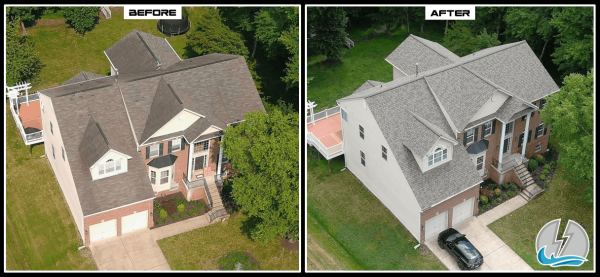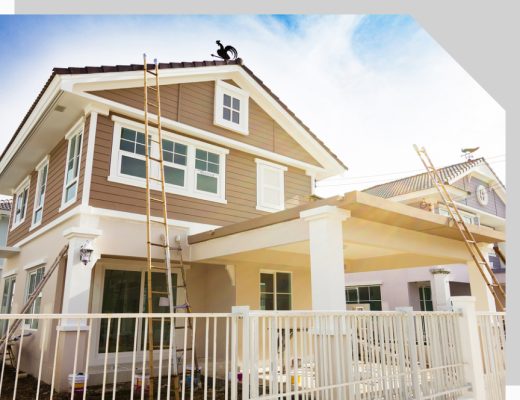Painting Your Siding: Tips & Tricks
Your home’s exterior is the first thing visitors see, so why not make a good impression? One of the easiest and most affordable ways to give your home a facelift is by painting the exterior siding. But before you grab a brush and get to work, there are a few things you need to know. Our Edgewater siding contractors are here to explain the most important aspects of painting exterior siding.
With over two decades of combined experience in exterior home improvement, they’ll walk you through the entire process, from prepping the surface to choosing the right paint and applying it like a pro. They’ll also help you weigh the pros and cons of a DIY painting job over hiring professionals like our experienced team.
Learn more by calling our Maryland siding company at 410-956-7663.

When You Should Paint Exterior Siding
Fading or Discoloration
Over time, exposure to the elements can cause your siding to fade or become discolored. Painting your siding can help restore its appearance and improve your home’s curb appeal.
Outdated Color
If your home’s exterior color is outdated or no longer to your liking, painting your siding can be a cost-effective way to update the look of your home.
Surface Damage
If your siding has minor surface damage, such as scratches or dents, painting it can help cover up these imperfections and improve the overall appearance of your home. Before painting, it’s crucial to check the condition of the existing siding and make any necessary repairs to ensure a smooth and durable finish.
Preventative Maintenance with a Fresh Coat of Paint
Painting your exterior siding can be a proactive way to protect it from future damage caused by exposure to the elements, such as UV rays, moisture, and pests.
Selling Your Home
If you’re planning to sell your home, painting the exterior siding can be a smart investment. A fresh coat of paint can improve your home’s curb appeal and help it stand out in a competitive real estate market.
When You Shouldn’t Paint Exterior Siding
Moisture or Water Damage
If your siding has moisture or water damage, painting it may only mask the problem temporarily. Address the underlying issue before painting to avoid further damage to your home’s structure.
Peeling or Flaking Paint
If your siding already has peeling or flaking paint, painting over it may not be effective. The new paint may not adhere properly to the old paint, resulting in an uneven and unattractive finish.
Mold or Mildew
If your siding has mold or mildew growth, painting over it won’t solve the problem. It may make it worse by trapping moisture underneath the paint and promoting further mold growth. Therefore, it is crucial to use a cleaning solution to effectively remove mold or mildew before painting.
Failing Siding
If your siding is old or damaged and needs to be replaced, painting it may not be a good solution. You’ll want to address the underlying issues with your siding before painting it.
Cold Temperatures
Painting exterior siding in cold temperatures can lead to problems such as poor adhesion, cracking, and peeling. Paint in optimal temperature conditions to ensure a successful and long-lasting finish.
Siding That Can’t Be Painted
Some types of siding shouldn’t be painted, as doing so may damage the material or its performance. For instance, pre-painted vinyl siding or fiber cement siding with a factory finish should not be painted over. To avoid issues, it’s essential to consult with the manufacturer or a professional contractor before attempting to paint any type of siding.

Mistakes to Avoid When Painting Your Exterior Siding
Avoiding common painting mistakes helps homeowners and other property owners achieve a professional-looking finish on their exterior siding. Common painting mistakes often include:
- Over-Applying Paint: Applying too much paint can cause it to drip, sag, or peel. To avoid this, apply thin coats of paint and wait for each coat to dry before applying the next.
- Under-Applying Paint: Applying too little paint can result in an uneven finish and leave your siding vulnerable to weather damage. Be sure to follow the manufacturer’s recommended coverage rates when applying paint.
- Not Using a Primer: Using a primer helps the paint adhere better to the surface and improves the durability of the paint job. Always use a primer on bare wood or when changing the color of your siding.
- Not Preparing the Surface Properly: Failing to clean and prepare the surface properly can cause the paint to peel or flake. Before painting, make sure to clean the surface of dirt, debris, and mildew and sand any rough areas.
- Painting in Extreme Weather Conditions: Painting in extreme heat, cold, or humidity can cause the paint to dry too quickly or not adhere properly. Aim to paint on days with mild weather conditions.
- Not Using the Right Tools: Using the wrong brushes, rollers, or spray equipment can lead to an uneven or streaky finish. Use the appropriate tools for the type of paint and surface you’re painting.
- Not Using Painter’s Tape: Using painter’s tape around doors, windows, and trims ensures clean lines and avoids mess during the painting process. Carefully remove the tape after the paint has dried to prevent damage to the newly painted surfaces.
Factors Affecting the Cost of Painting Exterior Siding
Painting the exterior siding of your home or other property can give it a fresh, updated look and improve its curb appeal. However, we recommend considering the cost of this project before diving in. The following factors will influence the total cost of your painting job:
- Size of The House: The larger the house, the more paint and time it will take to complete the job, which will increase the overall cost.
- Condition of The Siding: If your siding is in poor condition, it may require additional preparation work, such as power washing or sanding, which can increase the cost of the project.
- Type of Siding: Different types of siding, such as wood, vinyl, or brick, may require different types of paint or preparation, which can also impact the cost.
- Number of Stories: If your house has multiple stories, it may require additional equipment, such as scaffolding or ladders, to reach all areas of the siding, which can increase the cost.
- Labor Costs: Hiring a professional painter will likely be more expensive than doing the job yourself, but it can ensure a high-quality finish and save you time and effort.
- Use of Paint Sprayer: Using a paint sprayer for large areas can create a smooth and even coat, making the job more efficient. This can reduce labor time and potentially lower costs, though rollers and brushes may still be needed for corners and touch-ups.

How to Paint Exterior Siding: A Step-by-Step Guide
Clean and Prep the Surface
Before you start painting, you need to make sure the surface is clean and free of any dirt, debris, or mildew. Here’s what you’ll need to do:
- Use a power washer or hose to remove any loose dirt or debris.
- Scrub the surface with a solution of warm water, mild detergent, and powdered laundry detergent to effectively remove dirt and grime.
- Use a soft-bristled brush to scrub the surface, ensuring you remove all dirt, mold, and mildew without damaging the siding.
- Rinse thoroughly with clean water and let it dry completely.
- Use a paint scraper to remove any loose or peeling paint.
Repair Any Damage
Before you start painting, you need to make any necessary repairs to the siding. These repairs may include filling cracks, holes, or gaps, and replacing damaged or rotted boards.
- Use a putty knife to fill cracks, holes, or gaps with an exterior spackling compound.
- Sand the surface smooth once the compound has dried.
- Replace damaged or rotted boards.
- Prime bare wood or repaired areas with a high-quality exterior primer.
Choose the Right Paint
Choosing the right paint is crucial to achieving a long-lasting and beautiful finish. Here are some factors to consider when choosing paint for exterior siding:
- Type: Choose a high-quality, 100 percent acrylic latex paint for exterior use.
- Color: Choose a color that complements your home’s style and surroundings.
- Finish: Choose a finish that’s appropriate for the siding material (e.g. matte for wood siding, satin or semi-gloss for vinyl or aluminum siding).
- Quality: Choose a paint with good coverage, durability, and UV resistance.
- Vinyl Siding Paint: When painting vinyl siding, it is essential to use vinyl siding paint that contains acrylic and urethane resins. These ingredients ensure proper adhesion and flexibility, accommodating the expansion and contraction of the vinyl.
Apply the Paint
Now it’s time to start painting! Here are some tips for applying paint to exterior siding:
- Use a paint brush or roller to apply the paint in long, smooth strokes.
- Work in small sections, starting at the top and working your way down.
- Paint the trim and edges first, then fill in the larger areas.
- Be sure to follow the manufacturer’s instructions for application and drying times.
- Apply a second coat if necessary.
Frequently Asked Questions
Yes, you can paint your siding under certain conditions. Painting vinyl siding requires a thorough cleaning, selecting a paint formulated for vinyl, and using a primer to achieve a long-lasting and attractive finish. Proper cleaning is essential to remove dirt, grime, and mildew.
Using a primer before painting exterior siding is recommended for creating a smooth surface for paint adhesion, sealing small cracks, preventing moisture damage, and improving the final appearance of the paint job. Skipping primer may save time and money, but investing in a quality primer can prevent future damage and ensure a long-lasting finish.
How often you’ll need to repaint your siding will depend on several factors, including the type of siding material, the climate, and the quality of the paint. In general, a well-maintained exterior paint job can last anywhere from five to 10 years or more. However, if you notice any signs of peeling, cracking, or fading, it may be time to repaint.
The best time to paint exterior siding is during dry, mild weather conditions. Ideally, the temperature should be between 50 and 80°F with low humidity. Avoid painting during extreme temperatures or rainy or windy weather.
